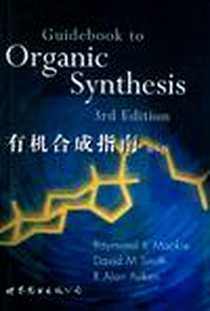《有机合成指南》
《有机合成指南》
出版时间:2001-4
出版社:世界图书出版公司
作者:R.K Mackie,D.M.Smith et al
页数:387
《有机合成指南》内容概要[E]
《有机合成指南(第3版)(英文版)》由世界图书出版公司出版,内容包括:Introduction、Functional group chemistry: the basics、Formation of carbon-carbon bonds: the principles、Formation of carbon-carbon bonds: reactions of organometallic compounds等。
《有机合成指南》书籍目录[E]
1 Introduction2 Functional group chemistry: the basics 2.1 Selectivity of organic reactions 2.2 Functionalization ofalkanes 2.3 Functionalization ofalkencs 2.4 Functionalization ofalkynes 2.5 Functionalization of aromatic hydrocarbons 2.6 Functionalization of substituted benzene derivatives 2.7 Functionalization of simple heterocyclic compounds 2.8 Interconversion of functional groups Summary3 Formation of carbon-carbon bonds: the principles 3.1 General strategy 3.2 Disconnections and synthons 3.3 Electrophilic carbon species 3.4 Nucleophilic carbon species Summary4 Formation of carbon-carbon bonds: reactions of organometalliccompounds 4.1 Grignard reagents and electrophiles 4.2 Other organometallic reagents and electrophiles 4.3 Reactions of nucleophiles derived from alk-l-ynes 4.4 Review 4.5 Worked examples Summary5 Formation of carbon-carbon bonds: the use of stabilized carbanionsand related nucleophiles 5.1 Carbanions stabilized by two -M groups 5.2 Carbanions stabilized by one -M group 5.3 Carbanions stabilized by neighbouring phosphorus or sulfur 5.4 Nucleophilic acylation 5.5 Alkene, arene and heteroarene nucleophiles 5.6 Review 5.7 Worked examples Summary6 Formation of carbon-heteroatom bonds: the principles 6.1 Carbon-halogen bonds 6.2 Carbon-oxygen, carbon-sulfur and carbon-selenium bonds 6.3 Carbon-nitrogen and carbon-phosphorus bonds 6.4 Carbon-silicon bonds Summary7 Ring closure (and ring opening) 7.1 lntramolecular cyclization by electrophile-nucleophile interaction 7.2 Cycloaddition 7.3 Electrocyclic ring closure 7.4 Ring opening 7.5 Review 7.6 Worked examples Summary8 Reduction 8.1 Catalytic hydrogenation 8.2 Metal hydride reductions 8.3 Electron-transfer reactions 8.4 Reduction of specific functional groups 8.5 Reductive cleavage of carbon-heteroatom bonds 8.6 Reductive ring opening of oxiranes 8.7 Reduction Of a/B-unsaturated carbonyl compounds 8.8 Reduction of conjugated dienes 8.9 Reduction of aromatic and heteroaromatic compounds Summary……9 Oxidation10 Protective groups11 Boron reagents12 Phosphorus reagents13 Silicon reagents14 Selenium reagents15 Asymmetric synthesis16 Selected syntheseEndnotes to the textFurther readingIndex